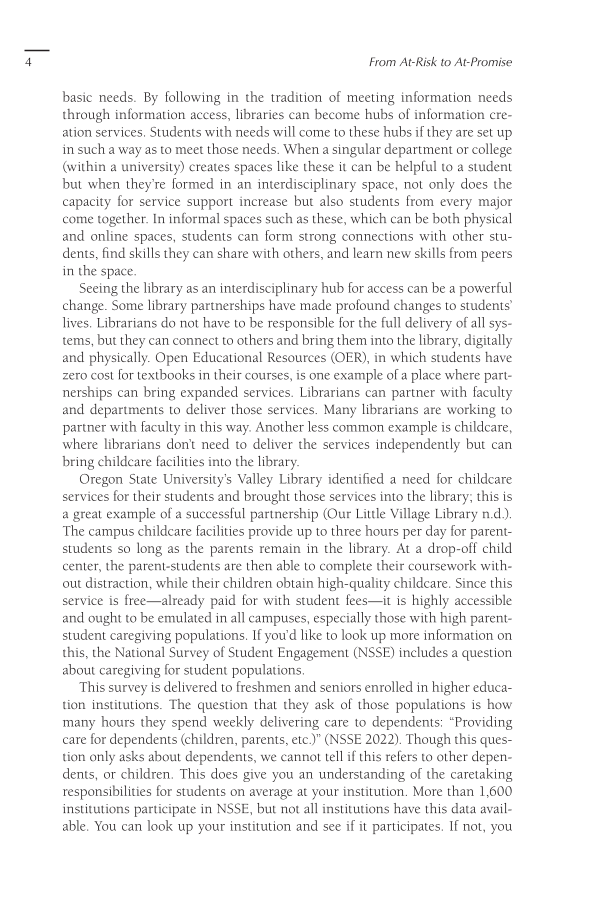4 From At-Risk to At-Promise basic needs. By following in the tradition of meeting information needs through information access, libraries can become hubs of information cre- ation services. Students with needs will come to these hubs if they are set up in such a way as to meet those needs. When a singular department or college (within a university) creates spaces like these it can be helpful to a student but when they’re formed in an interdisciplinary space, not only does the capacity for service support increase but also students from every major come together. In informal spaces such as these, which can be both physical and online spaces, students can form strong connections with other stu- dents, find skills they can share with others, and learn new skills from peers in the space. Seeing the library as an interdisciplinary hub for access can be a powerful change. Some library partnerships have made profound changes to students’ lives. Librarians do not have to be responsible for the full delivery of all sys- tems, but they can connect to others and bring them into the library, digitally and physically. Open Educational Resources (OER), in which students have zero cost for textbooks in their courses, is one example of a place where part- nerships can bring expanded services. Librarians can partner with faculty and departments to deliver those services. Many librarians are working to partner with faculty in this way. Another less common example is childcare, where librarians don’t need to deliver the services independently but can bring childcare facilities into the library. Oregon State University’s Valley Library identified a need for childcare services for their students and brought those services into the library this is a great example of a successful partnership (Our Little Village Library n.d.). The campus childcare facilities provide up to three hours per day for parent- students so long as the parents remain in the library. At a drop-off child center, the parent-students are then able to complete their coursework with- out distraction, while their children obtain high-quality childcare. Since this service is free—already paid for with student fees—it is highly accessible and ought to be emulated in all campuses, especially those with high parent- student caregiving populations. If you’d like to look up more information on this, the National Survey of Student Engagement (NSSE) includes a question about caregiving for student populations. This survey is delivered to freshmen and seniors enrolled in higher educa- tion institutions. The question that they ask of those populations is how many hours they spend weekly delivering care to dependents: “Providing care for dependents (children, parents, etc.)” (NSSE 2022). Though this ques- tion only asks about dependents, we cannot tell if this refers to other depen- dents, or children. This does give you an understanding of the caretaking responsibilities for students on average at your institution. More than 1,600 institutions participate in NSSE, but not all institutions have this data avail- able. You can look up your institution and see if it participates. If not, you
Document Details My Account Print multiple pages
Print
You have printed 0 times in the last 24 hours.
Your print count will reset on at .
You may print 0 more time(s) before then.
You may print a maximum of 0 pages at a time.


























































































































































